Torcello ★★
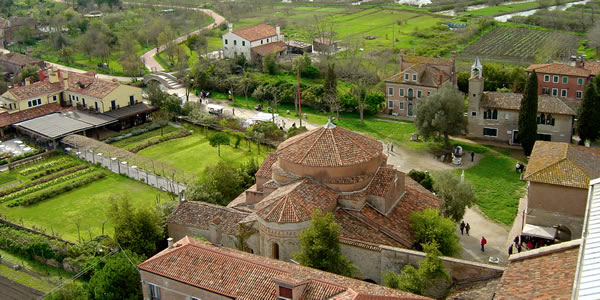
A panorama of green, undeveloped Torcello from the cathedral belltower. (Photo by Alex Proimos)
Glittering mosaics, breathtaking views, and a marshy proto-Venice in the Venetian Northern Lagoon
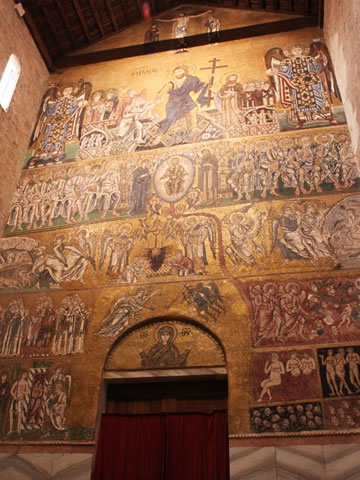
Some of the mosaics inside the Torcello cathedral. (Photo by Luis Eduardo P Tavares)
Before there was a "Venice," there was Torcello.
Grassy, semi-deserted Torcello is pretty much a one-trick pony: glittering Byzantine mosaics in a cathedral oddly stranded in the middle of a desolate, largely abandoned mud island. There's a reason for that.
Venice 1.0
Torcello was Venice 1.0, the first of the lagoon islands to be called home by a mainland population fleeing the Barbarian hordes that overran the Italian peninsula during the Dark Ages.
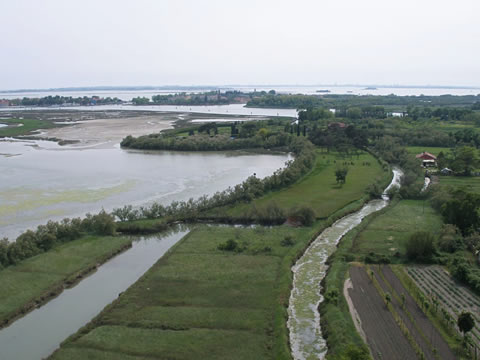
A view of sleepy Torcello from atop the bell tower. (Photo by Vyacheslav Argenberg)
Its marshy badlands give you the best feeling for what Venice looked like when people first started settling there.
Torcello was a thriving center of some 20,000 souls from the 7th to 11th centuries. It was from here that settlers first started moving to the area around the Rialto Bridge to build what we now know as Venice.
Starting in the 11th and 12th centuries, however, malaria and competition from the upstart community of La Serenissima set in and quickly depopulated the isle.
Venice scavenged the ruins for building materials, so most of its buildings and palaces have now utterly vanished.
Torcello now runs on a skeleton crew of 75 inhabitants (though that's up from 20 just a few decades ago).
Today Torcello consists of little more than one long canal leading from the ferry landing past sad-sack vineyards to a clump of buildings around a sun-bleached dirt-and-gravel square at its center.
The Devil's Bridge
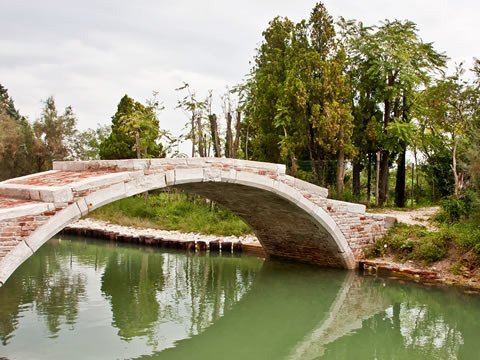
The Devli's Bridge on Torcello. (Photo by Andrés Nieto Porras)
From the ferry dock, follow the long
main canal on a 10-minute stroll to the main piazza.
Along the way, you'll pass the storied Cipriani (one of Venice's finest restaurants in the oddest location for one; see below) and a side canal branching off to the right.
Notice the wooden pilings hammered into the edges of the muddy bank. Atop such pilings all the stone palazzi of Venice itself are built. The anaerobic atmospehre down in the mud keeps the wood from rotting—but does nothing to keep the weight of all that stone from pressing them slowly farther into the mud while, simultaneously, the levels of the Adriatic Sea rise imperceptibly, sinking the city of Venice ever so slowly into the lagoon.
A bit farther along you'll pass a lithe, wafer-thin span of brick-and-stone without railings nicknamed "The Devil's Bridge." it was built in the 15th century (and restored in 2008), and its name—Ponte del Diavolo—is most likely merely a fun corruption of "Diavoli," the name of a local family.
The legend, though, is far more fun.
The legend of Torcello's Devil's Bridge
There are many legends in Europe of particularly odd-looking bridges having been built by the Devil—usually in the span of just one night, and usually in exchange for souls or some other macabre favor.
The legend of the Devils' Bridge on Torcello has a slightly different twist.
They say that, during the Austrian occupation of Venice (1797–1849) a local girl fell in love with a young Austrian officer, but her parents forbade them to see one another. When that didn't take, eventually they had the poor boy killed.
The distraught girl approached a witch to ask for her help, and the witch made a deal with the Devil on her behalf: Return the slain boy to life, and they would gather seven fresh new souls of children to replace his.
The devil held up his end of the bargain. He appeared as scheduled one night at the foot of the bridge with the boy. The with appeared at the other end with the girl. The lovers dashed across the bridge and met in the middle to embrace... then ran away together.
The Devil looked to the witch, who remained, and demanded his payment.
Now on the hook for seven souls, the witch asked for another week to procure them and the Devil agreed. Luckily for area youngsters attached to their souls, the witch died before that next appointment.
They say the Devil still comes to the foot of this bridge on moonless nights, waiting at the far side for his payment.
Waiting for an unclaimed soul to wander over the bridge and become his.
The Cathedral of Torcello
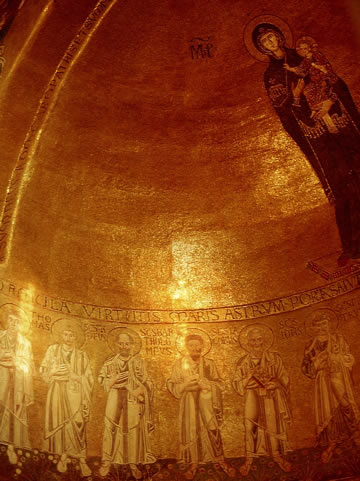
The golden 12th century mosaics in the apse dome of the Basilica of Santa Maria Assunta on Torcello (Photo by AnRo0002).
On the main (only) square in town are two churches: the more elaborate-looking (but only on the outside) church of Santa Fosca (more on that in a moment), and the plain-jane brick facade of
Venice's oldest monument and one of the prettiest churches in all of Greater Venice: the
Cattedrale di Torcello (Basilica di Santa Maria Assunta), whose foundation dates to AD 639—though the current edition was built in 1008.
The cathedral is famous for its outstanding 11th- to 12th-century Byzantine mosaics—a Madonna and Child in the apse and a Last Judgment on the west wall—glowing walls of gold-flecked art to rival those of Ravenna and of St. Mark's Basilica itself.
(Technically, it's no longer a cathedral since there's no bishop on Torcello, but everyone still calls it that.)
The cathedral (tel. +39-041-730-119 or +39-041-296-0630) is open daily Mar-Oct 10:30am to 5:30pm; Nov-Feb 10am–5pm. (Adm).
Santa Fosca
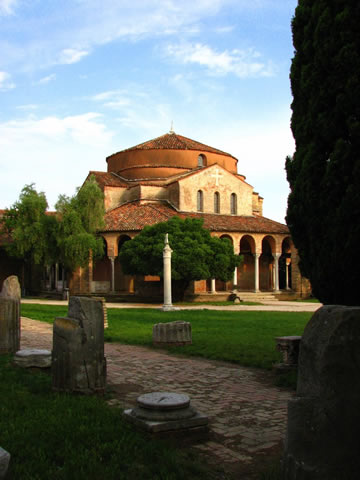
The church of Santa Fosca. (Photo by Molamoni)
Next door to the cathedral is the simple, spare 11th-century Greek cross church dedicated to
St. Fosca, a martyr from Ravenna who was buried here alongside her nurse and fellow martyr, St. Maura.
The octagonal columned portico and russet drum of its center look impressive, but the inside is nearly bare—though in a lovely way, with Byzantine capitals on the marble columns and a conical wooden ceiling.
Santa Fosca (tel. +39-041-730-084) is open daily 10am to 4:30pm. Admission is free.
The small Archaeological Museum of Torcello
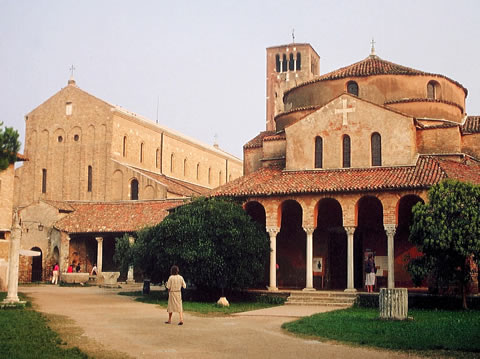
The main square on Torcello, with S. Fosca to the right and the cathedral to the left. (Photo by AnRo0002)
Across the dusty square from the pair of churches is Torcello's dinky, yet grandly named,
Museo Archeologico della Provincia di Venezia di Torcello (
tel. +39-041-296-0630;
sbmp.provincia.venezia.it).
The tidy collection is split between archaeological fragments and the remains of some 10 other churches that once sprinkled Torcello's landscape. (Believe it or not, at its height Torcello supported 16 parishes.)
The Torcello museum open Tuesday to Sunday: Mar-Oct 10am–5:30pm; Nov-Feb 10am–5pm. (Adm).
The rest of Torcello

A quiet canal and the bell tower of Torcello. (Photo by Daniel Daranas)
Aside from a lone, tipsy
campanile (bell tower) you can climb for some really nice views (last entry: 5pm Mar-Oct, 4pm in winter; closed in 2008 for restoration work; check to see if it has reopened at
tel. +39-041-296-0630), the rest of the island is given over to one
scraggly vineyard and several
swampy canals outlined by logs hammered into the muddy banks (again, a glimpse at how Venice looked before the stone palazzi were built).
Oh, and there's also a world-famous restaurant.
Locanda Cipriani: A famous restaurant in the middle of nowhere
Somewhat incongruously, the island is also home to a world-famous restaurant (famous because Hemingway loved it) called Locanda Cipriani (www.locandacipriani.com). Yes, that Cipriani, of various "Ciprianis" around the world—not to mention Harry's Bar in downtown Venice (the original Cipriani's first name was Arrigo, which is Italian for "Harry.") Book ahead for a meal.
Tips & links
Details
Tours
Take a tour: If you don't want to bother with the hassle of timing your
vaporetto stops—or simply want a guide along to explain what you're seeing—take a guided tour:
How long does Torcello take?
Planning your day on the outlying islands: You can easily be done with this tiny island in an hour while you wait for the next ferry (half-hourly), but if you take time to tramp around à la Hemingway, you might stay for two (just don't get stuck when the last "9" ferry for the night heads back to Burano at 8:10pm).. Venice itineraries
How to see everything before it closes
Santa Fosca closes at 4:30pm; last entry to the museum and bell tower are at 5pm (4pm winter); and last entry to the basilica is 5:30pm (4:30pm winter), so do them in that order to fit them all in.
How do I get to Torcello?
How to get to Torcello: Take the "9" ferry from Burano; getting to Burano, though, can get a bit complicated, and is explained in detail on a separate page. » more
Get the cumuative ticket
Go ahead and get the €10 cumulative ticket for all three sights with entry fees (the cathedral at €4, campanile/bell tower at €4, and archeological museum at €3). Bonus: it comes with a free audioguide (which is otherwise €1).
Mass at the basilica
Mass is still said at the basilica at 9:30am Sundays, 4:30pm weekdays.
Nearby sights, dining, hotels
Venice links & resources
- Airport transfers: By land (to Piazzale Roma)
- Atvo.it (shuttle bus: €6)
- Actv.it (city bus: €6)
- Venice rail station
- Venezia Santa Lucia: Grandistazioni.it, Fondamenta S. Lucia (in the NW corner of the city)
- Vaproetto to San Marco: 1, 2, N
- Driving/parking
- Asmvenezia.it (Piazzale Rome garage: most central, €23–29; S. Giuliano lot: farthest, €12)
- Veniceparking.it (Tronchetto garage: fairly central, €21)
- Car resources
- Emergency service/tow: tel. 803-116
- Highway agency: Autostrade.it (traffic info, serivce areas, toll calculator, weather)
- Italian automotive club (~AAA): Aci.it
- ZTLs: Ztl-italia.blogspot.com (lightly outdated, but handy, links to cities' traffic-free zones)
Walks & Day tours
Longer tours
Share this page

Search ReidsItaly.com







